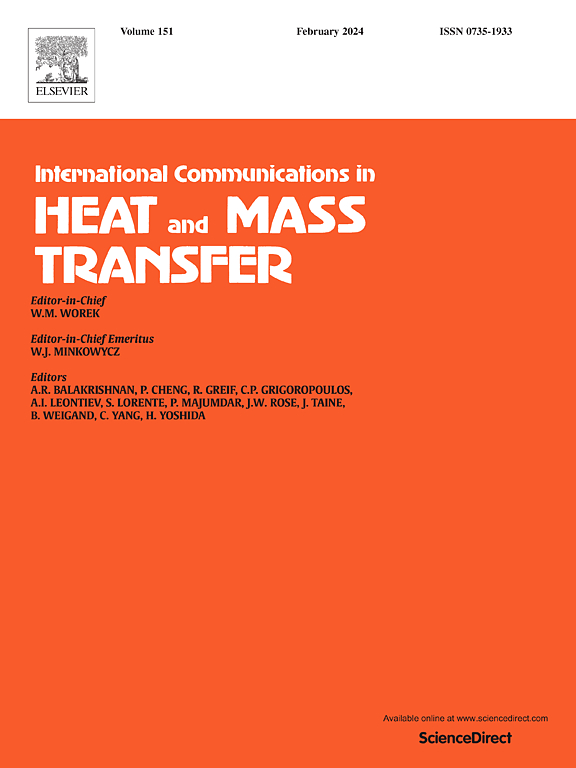中尺度微波反应器中混沌流动与电磁加热的多物理场耦合
IF 6.4
2区 工程技术
Q1 MECHANICS
International Communications in Heat and Mass Transfer
Pub Date : 2025-06-14
DOI:10.1016/j.icheatmasstransfer.2025.109199
引用次数: 0
摘要
在微纳流体系统中,混沌流动在增强层流混合和传热方面具有显著优势,但在化学、食品科学和生物等中尺度系统中,多物理场过程耦合混沌流动与强化传热技术(如电磁技术)的关系尚不清楚。本文设计了一种中尺度混沌流微波加热系统,以提高传热传质效率。通过数值模拟和实验验证,系统研究了cm尺度下c型几何混沌流的混合和换热特性。考虑周期间隔(Ld)和展弦比(W/H)等c型几何周期参数,研究了混沌流混合和电磁换热特性。结果表明,与传统的微波加热结构相比,c型几何混沌流与电磁热的耦合显著改善了混合传热。当20mm≤Ld <;30mm时,反应器性能可维持在较好的水平。W/H引起的截面变形对流体扰动和温度场分布有关键影响。为了防止管道的截面高度过高,同时为了减少由于惯性力作用,流体撞壁后扩散而产生的混合效果,建议W/H的取值范围为1≤W/H <;3. 同时,为避免微波加热一段时间后产生高发热量,应将W/H控制在2≤W/H≤5/2。该研究为理解多物理场过程耦合混沌流动与中尺度系统强化换热技术之间的关系奠定了理论基础。本文章由计算机程序翻译,如有差异,请以英文原文为准。
Multiphysics coupling of chaotic flow and electromagnetic heating in a mesoscale microwave reactor
Chaotic flow has significant advantages in enhancing laminar mixing and heat transfer in micro-nanofluidic systems, but the multiphysic process coupling chaotic flow with heat transfer enhancement technologies such as electromagnetic techniques in mesoscale systems accross such as chemistry, food science, and biology fields is still unclear. In this study, a mesoscale chaotic flow microwave heating system was designed to enhance the efficiency of mass and heat transfer. The mixing and heat transfer characteristics of C-type geometric chaotic flow at centimeter scale were systematically studied by numerical simulation and experimental verification. The characteristics of chaotic flow mixing and electromagnetic heat transfer were studied by considering the C-type geometric period parameters such as period spacing (Ld) and aspect ratio (W/H). The results show that, compared with the traditional microwave heating structure, the coupling of C-type geometric chaotic flow and electromagnetic heat significantly improves the mixing and heat transfer. When 20 mm ≤ Ld < 30 mm, the reactor performance can be maintained at a better level. The cross-section deformation caused by W/H has a key influence on fluid disturbance and temperature field distribution. In order to prevent the section height of the pipeline from being too high, and to reduce the mixing effect due to the spreading of the fluid after hitting the wall due to the inertial force, it is recommended that the value range of W/H be 1 ≤ W/H < 3. At the same time, in order to avoid high heat area after microwave heating for a certain time, W/H should be controlled at 2 ≤ W/H ≤ 5/2.This study lays a theoretical foundation for understanding the relationship between multi-physics process coupled chaotic flow and enhanced heat transfer technology in mesoscale systems.
求助全文
通过发布文献求助,成功后即可免费获取论文全文。
去求助
来源期刊
CiteScore
11.00
自引率
10.00%
发文量
648
审稿时长
32 days
期刊介绍:
International Communications in Heat and Mass Transfer serves as a world forum for the rapid dissemination of new ideas, new measurement techniques, preliminary findings of ongoing investigations, discussions, and criticisms in the field of heat and mass transfer. Two types of manuscript will be considered for publication: communications (short reports of new work or discussions of work which has already been published) and summaries (abstracts of reports, theses or manuscripts which are too long for publication in full). Together with its companion publication, International Journal of Heat and Mass Transfer, with which it shares the same Board of Editors, this journal is read by research workers and engineers throughout the world.

 求助内容:
求助内容: 应助结果提醒方式:
应助结果提醒方式:


